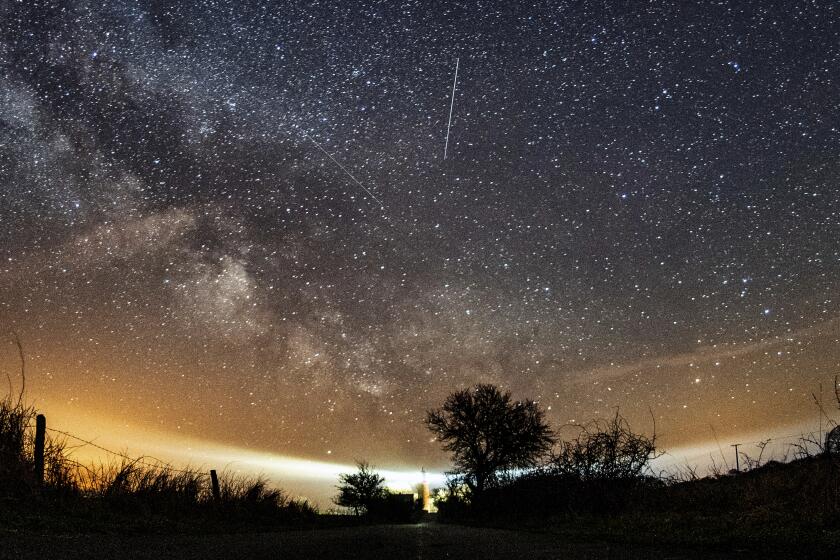He’s a farmer till the end
- Share via
James Hatano turns off one of the Palos Verdes Peninsula’s oceanfront drives and onto a hidden dirt road, just as he has for more than 50 years. He guides his Buick LaCrosse up a gentle hill to the fields where he raises cacti and flowers.
While he works, Hatano can look out at the Pacific and see whales and dolphins.
As he chops off a beavertail cactus paddle, he gazes across Palos Verdes Drive West to where construction crews are putting the finishing touches on the 582-room Terranea resort with its nine-hole golf course, 25,000-square-foot spa and three pools.
Marineland of the Pacific once stood on the site. Before that, Hatano recalls, a man named Tomio Nakano raised tomatoes there. What is now Trump National Golf Club, he says, was once barley and vegetable fields.
“This area’s all full of homes, but it used to be full of garbanzo fields,” Hatano says. “I didn’t even know what garbanzos were until I came up here.”
Hatano, 82, is the last farmer on the Palos Verdes Peninsula -- and the last link to a Palos Verdes few remember, one dotted with farms worked by Japanese immigrants and their families. Their garbanzo beans and tomatoes, nourished by rain and ocean mists, were known worldwide.
The area near Donald Trump’s golf course was once farmed by the Ishibashis, Hamadas and Yakotas. At Portuguese Bend were the Kubotas and Ohnos. At Lunada Bay were the Hatshitos, Sadadas and Takenagas.
For $631 a year, Hatano leases two sites totaling 14 acres from the city of Rancho Palos Verdes. He still drives to his fields several times a week to make sure things are running smoothly.
“What am I going to do? It’s all I know, and that’s not much, either,” Hatano says -- following up, as he always seems to, with a laugh.
When he retires, the land will revert to the city and a century-old tradition will end. “It represents our last connection to a previous way of life,” says Judi Gerber, author of “Farming in Torrance and the South Bay.” “I know that way of life is gone, but it’s living history.”
--
A plaque at Founders Park, behind the clubhouse at Trump National, marks the site of the first Japanese American farmhouse on the Palos Verdes Peninsula, built in 1906 by Kumekichi Ishibashi.
In the early 1900s, the manager of the Bixby Ranch began renting land for $10 an acre to Japanese immigrants who grew vegetables, and eventually more than 200 Japanese families farmed in the area. Laws restricted property ownership by Japanese immigrants.
After the attack on Pearl Harbor, the Japanese farmers were forced into internment camps, sometimes with crops in the field waiting to be picked. Few returned to Palos Verdes after the war, although Ishibashi’s descendants operated a roadside produce shop, Annie’s Stand, in Abalone Cove until 2002.
Hatano was something of a latecomer. He was raised around Porterville, where his parents grew watermelons, peas and beans. During World War II, his family was sent to an internment camp in Poston, Ariz., where he met the families of many of the Palos Verdes farmers.
After leaving the Army in the late 1940s, Hatano wasn’t doing much of anything, other than collecting $20 a month in separation pay.
“That was good money then,” he says.
His brother-in-law thought it was time he settled down. “He said, ‘Instead of wandering around and doing nothing, why don’t you grow flowers?’ ” Hatano recalls.
Soon he was farming 10 acres in Redondo Beach. When the owner decided to sell, Hatano looked for suitable land elsewhere. He found himself on the peninsula. He settled on what is now the site across from the Terranea resort. Back then, it was owned by the Army. He signed a lease, cleared the land and put in sprinklers made of steel pipe.
“Oh, God, that stuff was heavy,” he says.
Once, while working the land, he turned over a rock and a rattlesnake bit him on the hand. He was taken by helicopter to a hospital.
The plot, near Rancho Palos Verdes City Hall, has rows of artichokes and flowers, but mainly it’s a sea of prickly pear cactus. Hatano started raising cacti years ago at the suggestion of his workers. The crop is his biggest seller. The buyers are mainly Mexican restaurants, which make nopalitos from the cactus pads.
When the city of Rancho Palos Verdes needed a parking lot in the 1980s, Hatano traded a portion of the site for a lease on 8 1/2 acres near Point Vicente Lighthouse, a little more than a mile south.
He has been tending the two plots ever since, even as development has closed in around him.
Hatano and his wife raised their five children in a rented house in Rancho Palos Verdes. In a typical Palos Verdes story, the house was knocked down and replaced by a Spanish-style mansion. For the last 20 years, the couple have lived in San Pedro.
His wife, Rumi, has tried to talk Hatano into retiring, with no luck.
“He still enjoys doing this,” she says. “That’s his life.”
Despite his age, he stands straight -- although he’s not the 5 feet 4 he once was -- and walks with a sturdy gait.
Asked when he’ll retire, he says: “When my legs give out.”
--
Until a few years ago, Hatano would wake up at 1:30 a.m. three days a week to sell his flowers at the Southern California Flower Market in downtown Los Angeles. He was out of the house by 2 a.m., his van packed with sunflowers, baby’s breath, poppies, delphinium and cacti picked the day before.
Before the Harbor Freeway was completed in the 1960s, he would take Figueroa Street from Palos Verdes through the empty city, arriving at his market stall by 3 a.m. He’d spend the next six hours selling his crop, mainly to florists but also to shippers who would pack the flowers on ice and fly them east. He would head home for a nap and lunch. Then he would work his fields.
He almost never took a day off.
Hatano’s son, Doug, 54, is the only one of his children who has tried farming. He now lives in Santa Maria and works on an offshore oil rig, seven days on, seven days off. When he’s not on the rig, he drives down to help his father.
“This is his day off,” James Hatano says with a laugh as his son packs his van with flowers for the next day’s flower market.
Helping the son are two workers with long-standing ties to Hatano. Martin Martinez’s father and uncle worked for Hatano for 25 years, and Martinez and his cousin have taken their places. Hatano worries what will happen to them if he retires.
“They have no place to go,” he says.
About 10 months ago, Hatano’s children persuaded him to slow down. They met him at the house in San Pedro for a family council of sorts and suggested he give up those early morning trips to the flower market and spend less time in the fields.
“The long hours were starting to take a toll on him,” says his daughter, Dorothy Scheid, a Hermosa Beach police sergeant. “We just felt he should slow down. He’s just a plain hardworking man, not used to taking an easy day ever.”
Now he checks on his crops just three days a week, when flowers are being readied for the market, leaving the hard work and the flower market mainly to his son and Martinez.
“He’s getting tired,” his wife says. “You can see it in him. He keeps saying, ‘Everybody’s gone. I’m the only one here.’ But he says he’ll stay here until Rancho Palos Verdes takes over.”
Hatano can cultivate the land across from Terranea for as long as he wants, city officials have said. None of his children has any interest in taking over.
He may lose the plot near the lighthouse sooner. As he watched his son and his two workers pick flowers there, surveyors prepared the land for a $40-million nature center to be built by the Annenberg Foundation.
Hatano just shrugs. “At this stage of the game, nothing bothers me,” he says.
“This was the best thing I did, coming here.”
--
More to Read
Sign up for The Wild
We’ll help you find the best places to hike, bike and run, as well as the perfect silent spots for meditation and yoga.
You may occasionally receive promotional content from the Los Angeles Times.







